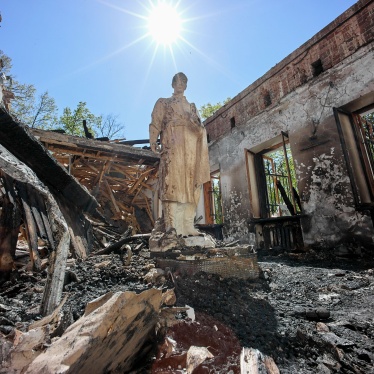(Jerusalem) - Israel's repeated firing of white phosphorus shells over densely populated areas of Gaza during its recent military campaign was indiscriminate and is evidence of war crimes, Human Rights Watch said in a report released today.
The 71-page report, "Rain of Fire: Israel's Unlawful Use of White Phosphorus in Gaza," provides witness accounts of the devastating effects that white phosphorus munitions had on civilians and civilian property in Gaza. Human Rights Watch researchers in Gaza immediately after hostilities ended found spent shells, canister liners, and dozens of burnt felt wedges containing white phosphorus on city streets, apartment roofs, residential courtyards, and at a United Nations school. The report also presents ballistics evidence, photographs, and satellite imagery, as well as documents from the Israeli military and government.
Militaries use white phosphorus primarily to obscure their operations on the ground by creating thick smoke. It can also be used as an incendiary weapon.
"In Gaza, the Israeli military didn't just use white phosphorus in open areas as a screen for its troops," said Fred Abrahams, senior emergencies researcher at Human Rights Watch and co-author of the report. "It fired white phosphorus repeatedly over densely populated areas, even when its troops weren't in the area and safer smoke shells were available. As a result, civilians needlessly suffered and died."
The report documents a pattern or policy of white phosphorus use that Human Rights Watch says must have required the approval of senior military officers.
"For the needless civilian deaths caused by white phosphorus, senior commanders should be held to account," Abrahams said.
On February 1, Human Rights Watch submitted detailed questions to the Israel Defense Forces (IDF) about its white phosphorus use in Gaza. The IDF did not provide responses, citing an internal inquiry being conducted by the Southern Command.
In the recent Gaza operations, Israeli forces frequently air-burst white phosphorus in 155mm artillery shells in and near populated areas. Each air-burst shell spreads 116 burning white phosphorus wedges in a radius extending up to 125 meters from the blast point. White phosphorus ignites and burns on contact with oxygen, and continues burning at up to 1500 degrees Fahrenheit (816 degrees Celsius) until nothing is left or the oxygen supply is cut. When white phosphorus comes into contact with skin it creates intense and persistent burns.
When used properly in open areas, white phosphorus munitions are not illegal, but the Human Rights Watch report concludes that the IDF repeatedly exploded it unlawfully over populated neighborhoods, killing and wounding civilians and damaging civilian structures, including a school, a market, a humanitarian aid warehouse, and a hospital.
Israel at first denied it was using white phosphorus in Gaza but, facing mounting evidence to the contrary, said that it was using all weapons in compliance with international law. Later it announced an internal investigation into possible improper white phosphorus use.
"Past IDF investigations into allegations of wrongdoing suggest that this inquiry will be neither thorough nor impartial," Abrahams said. "That's why an international investigation is required into serious laws of war violations by all parties."
The IDF knew that white phosphorus poses life-threatening dangers to civilians, Human Rights Watch said. A medical report prepared during the recent hostilities by the Israeli ministry of health said that white phosphorus "can cause serious injury and death when it comes into contact with the skin, is inhaled or is swallowed." Burns on less than 10 percent of the body can be fatal because of damage to the liver, kidneys, and heart, the ministry report says. Infection is common and the body's absorption of the chemical can cause serious damage to internal organs, as well as death.
If the IDF intended to use white phosphorus as a smokescreen for its forces, it had a readily available non-lethal alternative to white phosphorus - smoke shells produced by an Israeli company, Human Rights Watch concluded.
All of the white phosphorus shells that Human Rights Watch found were manufactured in the United States in 1989 by Thiokol Aerospace, which was running the Louisiana Army Ammunition Plant at the time. On January 4, Reuters photographed IDF artillery units handling projectiles whose markings indicate that they were produced in the United States at the Pine Bluff Arsenal in September 1991.
To explain the high number of civilian casualties in Gaza, Israeli officials have repeatedly blamed Hamas for using civilians as "human shields" and for fighting from civilian sites. In the cases documented in the report, Human Rights Watch found no evidence of Hamas using human shields in the vicinity at the time of the attacks. In some areas Palestinian fighters appear to have been present, but this does not justify the indiscriminate use of white phosphorus in a populated area.
Human Rights Watch said that for multiple reasons it concluded that the IDF had deliberately or recklessly used white phosphorus munitions in violation of the laws of war. First, the repeated use of air-burst white phosphorus in populated areas until the last days of the operation reveals a pattern or policy of conduct rather than incidental or accidental usage. Second, the IDF was well aware of the effects of white phosphorus and the dangers it poses to civilians. Third, the IDF failed to use safer available alternatives for smokescreens.
The laws of war obligate states to investigate impartially allegations of war crimes. The evidence available demands that Israel investigate and prosecute as appropriate those who ordered or carried out unlawful attacks using white phosphorus munitions, Human Rights Watch said.
The United States government, which supplied Israel with its white phosphorus munitions, should also conduct an investigation to determine whether Israel used it in violation of the laws of war, Human Rights Watch said.







